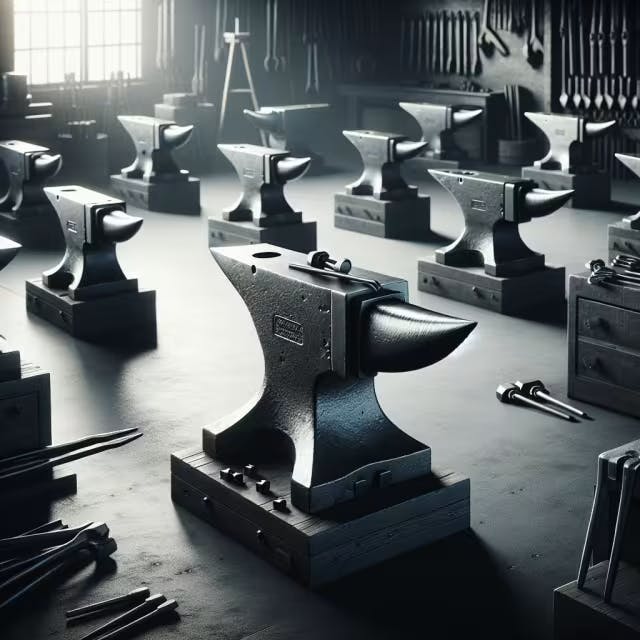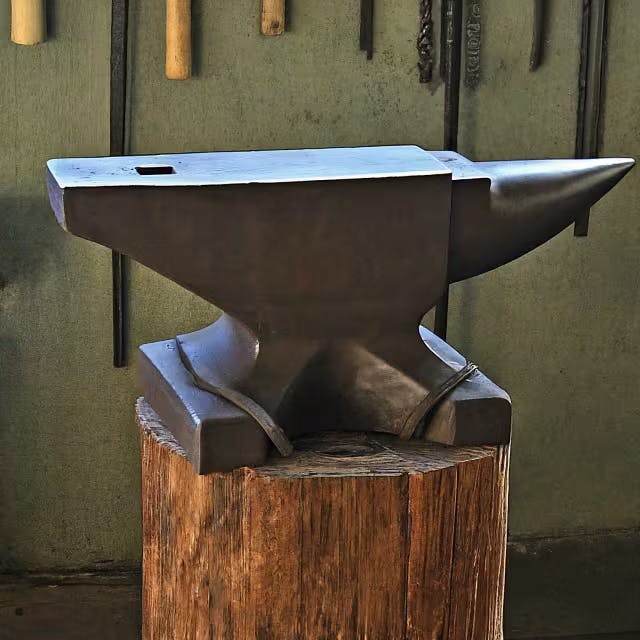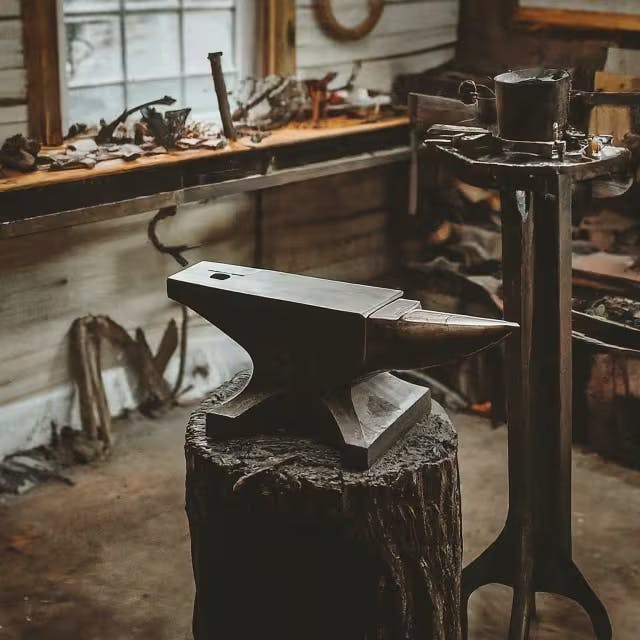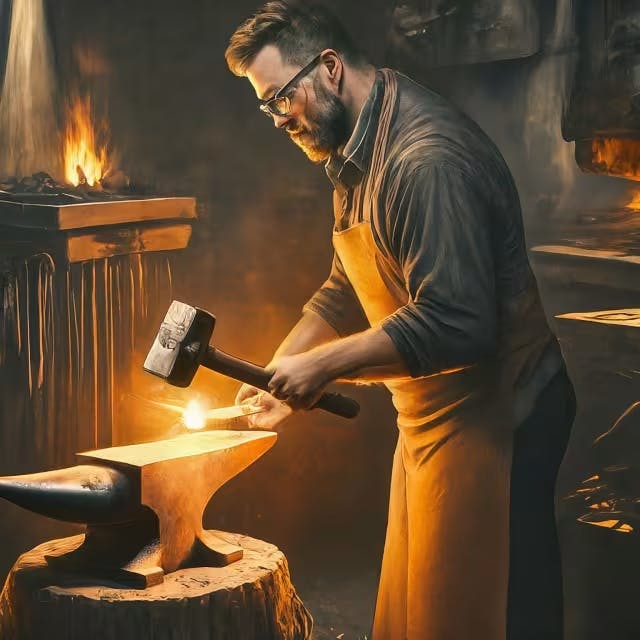Durable Anvil Stands for Forging Workshops
Abana Chapter
February 07, 2024

Forging excellence starts with having the right tools, and a durable anvil stand is as fundamental as the anvil itself for any forging workshop. As artisans invest in high-quality anvils to shape their metalwork with precision, it's crucial to complement this with an anvil stand that promises the same level of durability and stability. Understanding what constitutes a reliable anvil stand, and how to select one that aligns with specific forging needs, is essential for both novice and experienced metalworkers seeking to enhance their craftsmanship.
Key Takeaways
A durable anvil stand is crucial for achieving stability and precision in metalworking, just as much as the anvil itself.
Selecting the right anvil stand involves matching it with one's specific forging needs, such as the type of work being done and the size of the anvil.
High-quality anvil stands provide benefits such as improved safety, more efficient energy transfer, and better workmanship.
Regular maintenance of an anvil stand is important to extend its lifespan and ensure ongoing stability and performance.
The materials used in the construction of an anvil stand impact its durability; choosing the right materials can significantly enhance the stand's efficacy.
Understanding these factors and investing accordingly can significantly improve the proficiency and quality of work in any forging workshop.
Essential Features of Anvil Stands for Durability and Stability
Selecting the right anvil stand is crucial for a forging workshop, where it serves as the linchpin for blacksmithing tasks. A high-quality stand contributes significantly to the anvil's performance by providing a stable and level surface, which reduces vibrations and noise. Consistency in performance can be achieved with a stand that is made from heavy-duty materials like steel. Additionally, look for stands that feature adjustable height settings to accommodate different working postures and projects. The stand should also have a lockdown feature, ensuring the anvil remains secure during rigorous hammering. Another important aspect is the stand's footprint; it should not be too large, occupying unnecessary floor space, nor too small, compromising on stability. Here's a quick rundown of features that exemplify a durable and reliable anvil stand for any forging workshop:
Feature | Benefit |
Heavy-duty material | Sturdy support reducing vibration and noise |
Adjustable height | Ergonomic comfort for various projects and users |
Lockdown capability | Safeguards the anvil from shifting |
Efficient footprint | Maximizes workspace without sacrificing stability |
For a comprehensive list of features and considerations when choosing an anvil stand for your forging workshop, you can count on resources like forecast.weather.gov for detailed guidelines.

Choosing the Right Anvil Stand for Your Forging Needs
When selecting the perfect anvil stand for your workshop, the key factors to consider include the stand's material, stability, height, and base dimensions. The material should withstand repeated heavy blows without deforming or breaking, such as steel or heavy timber. Stable anvil stands prevent movement during work, ensuring both safety and precision. Adequate height is vital for maintaining proper posture during forging, thus a customizable or appropriate-sized stand should be a priority. The base dimensions should provide enough floor contact to support the anvil securely.
Below is a table that outlines some specifications to look for in an anvil stand, helping to guide your purchase decision:
Feature | Specification | Why It Matters |
Material | Steel or Heavy Timber | Durability and ability to absorb shock |
Stability | Wide-footed or Bolt-Down | Safety and precision during work |
Height | 32" - 34" Standard | Ergonomics and comfort for the blacksmith |
Base | Depends on Anvil Size | Ensures anvil is securely supported |
Keep in mind the specific needs of your forging projects when choosing an anvil stand. For instance, larger projects may require a stand with a broader base for additional support. Seasoned blacksmiths often favor custom stands crafted to their personal preferences, which is something to consider for long-term comfort and effectiveness. Always invest in quality stands that align with safety standards to prevent accidents and ensure longevity in your forging endeavors. To find reliable stands suited to your workshop’s specific needs, explore options at specialized blacksmith supply stores or consider a custom-built anvil stand from a reputable manufacturer.
The right anvil stand is more than a workshop accessory; it's a foundation for all your forging creations.
The Benefits of Investing in a High-Quality Anvil Stand
Quality anvil stands are pivotal for effective forging, providing a stable platform that enhances accuracy and efficiency during hammering. A robust anvil stand minimizes vibration, allowing for more precise work on the metal. Additionally, the right stand height optimizes the blacksmith's posture, reducing fatigue and the risk of injury during prolonged tasks.
Advantage | Description |
Stability | A solid base reduces anvil movement and increases accuracy. |
Vibration Reduction | Decreases the transfer of energy, preventing fatigue. |
Ergonomic Design | Adjustments to stand height can prevent back strain. |
Longevity | High-quality materials resist wear and extend lifespan. |
Moreover, as detailed in a Stack Overflow blog, investing in quality parallels the principle of preventing technical debt. Just as clean, maintainable code is critical for long-term efficiency in software development, a durable anvil stand is a long-term investment in a blacksmith's craft. High-quality stands are not only a matter of performance but also support sustainable practices within the forging industry. Preventing issues like joint pain or equipment failure translates directly to uninterrupted and productive workshop operations.
Choosing a superior anvil stand can indeed slow initial setup times, akin to code development, but the payoff in terms of reduced maintenance and upgrade needs is invaluable. It allows blacksmiths to focus on their craft instead of dealing with equipment shortcomings, fostering a more creative and efficient working environment.

Tips for Maintaining Your Anvil Stand to Ensure Longevity
Maintaining your anvil stand is crucial for ensuring its durability and effectiveness in a forging workshop. Following a routine care regimen similar to how to clean a wooden cutting board, can prevent deterioration and preserve the stand’s integrity.
Regular Cleanings:
Clean your anvil stand with warm soapy water after heavy use to remove any metal filings or debris.
Wipe down the surface with a clean cloth and allow it to air dry completely before using it again.
Preventative Measures:
Avoid exposure to excessive moisture which can cause wooden stands to warp or metal stands to corrode.
Inspect your stand for any signs of wear or damage and address these issues promptly to avoid further complications.
Protection and Treatment:
For wooden stands, apply a coat of food-grade mineral oil to the surface to retain its moisture and prevent cracking, doing so when the stand no longer soaks up the oil. Optionally, you can add beeswax for extra protection.
For metal stands, apply a rust inhibitor or protective enamel to safeguard against oxidation.
By incorporating these practices, your anvil stand will remain a reliable fixture for years to come. Regular maintenance not only extends the life of the stand but also contributes to a safer and more efficient forging environment.

Understanding the Importance of Anvil Stand Construction Materials
Selecting the right construction materials for anvil stands is pivotal to ensure longevity and stability in a forging workshop. These stands must withstand the force of repetitive hammering while offering a stable workstation. Forging professionals often prefer stands constructed with solid steel or heavy timber, as these materials absorb vibrations and resist deformation over time.
Material | Advantages | Considerations |
Solid Steel | Extreme Durability, Vibration Absorption | Heavier, More Expensive |
Heavy Timber | Good Vibration Resistance, Aesthetics | Susceptibility to Wear |
Steel stands are lauded for their strength and vibration absorption, essential for precision forging. However, they may be heavier and on the pricier side, making them less portable and a more significant upfront investment. In contrast, timber stands offer a more traditional appeal and decent shock resistance but may require more maintenance and can degrade over time.
To assist smiths in making the right choice, recent analyses, such as those by Anvil Stand Experts, provide detailed comparisons of materials with real-world data on performance and durability. Careful selection based on these insights can lead to a well-equipped workshop where functionality, budget, and personal preferences are all aligned. In conclusion, selecting a durable anvil stand for your forging workshop is not only a matter of optimizing your work environment but is also a critical investment in the quality and safety of your craft. By understanding the essential features for durability and stability, and choosing a high-quality stand made from appropriate materials, you ensure a solid foundation for precise metalwork. Regular maintenance will further safeguard your anvil stand's longevity, allowing you to focus on the art of forging with confidence and peace of mind.
Frequently Asked Questions
What are the key features of durable anvil stands for forging workshops
Durable anvil stands in forging workshops offer a robust platform for a variety of metalworking activities, with key features designed to enhance performance and user experience. The main attributes of a reliable anvil stand include:
Heavy-duty Construction: Typically made from materials like solid steel or heavy timber, stands must resist vibration and withstand the force of hammer strikes.
Stability: A wide-footed or bolt-down base helps ensure the anvil does not move during work, which is critical for both safety and precision.
Adjustable Height: Providing the ability to adjust for ergonomics, this feature allows various users to maintain proper posture, minimizing fatigue and risk of injury.
Secure Fastening: Inclusion of a lockdown or clamp feature ensures the anvil remains in place during vigorous hammering to prevent accidents.
Efficient Footprint: The stand's base should optimize the workspace by being large enough for stability without taking up unnecessary room.
Maintenance Friendly: Regular cleaning with warm soapy water and periodic treatments, like rust inhibitors for steel or mineral oil for timber, enhance an item's longevity.
These characteristics, combined with specific adaptions for the individual blacksmiths' needs, such as base size modifications for larger projects or customized heights, create an indispensable tool within the forging workshop. Properly chosen, a durable anil stand can be an invaluable long-term asset, echoing the principle of investing in quality to minimize future issues and maintain a productive environment.
How does an adjustable height impact the ergonomics of forging work
An adjustable height on an anvil stand significantly improves the ergonomics of forging work by:
Ergonomic Comfort: Allowing users of different heights to work at a comfortable level, which reduces strain on their back, neck, and shoulders.
Versatility for Tasks: Adapting to various forging projects that may require different working heights for efficiency and precision.
Lockdown Feature: Ensuring that despite the height adjustment, the anvil remains secured during the dynamic forces of hammering, maintaining safety and consistency.
What are the benefits of a lockdown feature on an anvil stand
The benefits of a lockdown feature on an anvil stand include:
Enhanced Security: It ensures the anvil remains firmly in place during use, preventing movement that can affect the precision of your work and pose safety risks.
Stability During Forging: By locking down the anvil, vibrations are minimized, leading to more accurate strikes and cleaner work overall.
Protects Equipment: The lockdown feature helps in protecting the anvil and stand from potential damage caused by shifting or slipping while hammering.
Why is the footprint of an anvil stand important for work efficiency
The footprint of an anvil stand is crucial for maintaining work efficiency in a forging workshop for several reasons:
Optimal Space Utilization: A stand with an efficient footprint takes up just enough room to provide stability yet does not consume unnecessary workshop space, freeing up room for other tasks and equipment.
Stable Work Environment: A properly sized footprint ensures the anvil stand remains stable during use, reducing movement and allowing for more precise and effective hammering.
Safety Considerations: A stand that is too small may be prone to tipping or shifting, posing a risk to the blacksmith, while a stand that is too large can create a cluttered and hazardous work area.
What materials are best for constructing a long-lasting anvil stand
When selecting the perfect anvil stand for your workshop, the key factors to consider include the stand's material, stability, height, and base dimensions. The material should withstand repeated heavy blows without deforming or breaking, such as steel or heavy timber. Stable anvil stands prevent movement during work, ensuring both safety and precision. Adequate height is vital for maintaining proper posture during forging, thus a customizable or appropriate-sized stand should be a priority. The base dimensions should provide enough floor contact to support the anvil securely. Seasoned blacksmiths often favor custom stands crafted to their personal preferences, which is something to consider for long-term comfort and effectiveness. Always invest in quality stands that align with safety standards to prevent accidents and ensure longevity in your forging endeavors. To find reliable stands suited to your workshop’s specific needs, explore options at specialized blacksmith supply stores or consider a custom-built anvil stand from a reputable manufacturer.
How do you maintain an anvil stand to ensure its longevity and effectiveness
Maintaining your anvil stand involves regular cleaning and inspections to prevent deterioration and ensure stability for effective forging. Here are some guidelines to help ensure its longevity and performance:
Regular Cleanings:
Remove metal filings and debris after use by washing with warm soapy water and wiping the stand dry.
Preventative Measures:
Protect metal stands from moisture to prevent rust and apply rust inhibitors or protective coatings as necessary.
For wooden stands, prevent warping by avoiding moisture and treat the wood with mineral oil and beeswax for additional protection.
Regular maintenance following these steps will keep your anvil stand in optimal condition, contributing to safe and efficient blacksmithing.


